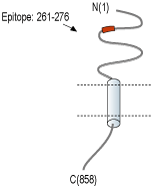Overview
- Peptide (C)DEKHIFSDDSSELTIR, corresponding to amino acid residues 261-276 of rat CD56 (NCAM1) (Accession P13596). Extracellular, N-terminus.

 Expression of CD56 in rat brainImmunohistochemical staining of rat olfactory bulb free-floating frozen sections using Anti-CD56/NCAM1 (extracellular)-ATTO Fluor-488 Antibody (#ANR-041-AG), (1:60). CD56 immunoreactivity (green) appears in glomerular structures (arrows). Nuclei are demonstrated using DAPI as the counterstain (blue).
Expression of CD56 in rat brainImmunohistochemical staining of rat olfactory bulb free-floating frozen sections using Anti-CD56/NCAM1 (extracellular)-ATTO Fluor-488 Antibody (#ANR-041-AG), (1:60). CD56 immunoreactivity (green) appears in glomerular structures (arrows). Nuclei are demonstrated using DAPI as the counterstain (blue).
- Johnson, C.P. et al. (2004) Proc. Natl. Acad. Sci. U.S.A. 101, 6963.
- Lanier, L.L. et al. (1991) J. Immunol. 146, 4421.
- Kiss, J.Z. and Muller, D. (2001) Rev. Neurosci. 12, 297.
- Arai, M. et al. (2004) Biol. Psychiatry 55, 804.
- Ćirović, S. et al. (2014) Int. J. Clin. Exp. Pathol. 7, 1402.
Neural cell adhesion molecule 1 (NCAM-1) is a member of a large family of cell-surface glycoproteins and plays a major role during development and controls various functions in the nervous system such as cell migration, neurite growth, axonal guidance, and synaptic plasticity1. NCAM-1 mediates adhesion between cells through homophilic bonds formed between its extracellular domains, which comprise five tandem Ig domains and two juxtamembrane fibronectin type III (Fn III) domains2. There are three major protein isoforms of NCAM-1: 180 kd, 140 kd, and 120 kd. The 180-kd and 140-kd isoforms of NCAM-1 are transmembrane proteins, whereas the 120-kd isoform is linked to the plasma membrane via a glycosyl phosphatidyl-inositol (GPI) lipid anchor3.
NCAM-1 is widely expressed in the central nervous system, skeletal muscle and natural killer cells4.
Several lines of evidence have supported the idea that dysregulation of NCAM-1 isoforms in the brain might be involved in the pathophysiology of neuropsychiatric disorders, particularly bipolar affective disorder5.
Application key:
Species reactivity key:
Anti-CD56/NCAM1 (extracellular) Antibody (#ANR-041) is a highly specific antibody directed against an epitope of the rat protein. The antibody can be used in western blot, live cell imaging, and immunohistochemistry applications. It has been designed to recognize CD56 from rat, mouse and human samples.
Anti-CD56/NCAM1 (extracellular)-ATTO Fluor-488 Antibody (#ANR-041-AG) is directly labeled with an ATTO-488 fluorescent dye. ATTO dyes are characterized by strong absorption (high extinction coefficient), high fluorescence quantum yield, and high photo-stability. The ATTO-488 label is analogous to fluorescein isothiocyanate (FITC) and can be used with filters typically used to detect FITC. Anti-CD56/NCAM1 (extracellular)-ATTO Fluor-488 Antibody is suited for experiments requiring simultaneous labeling of different markers.
